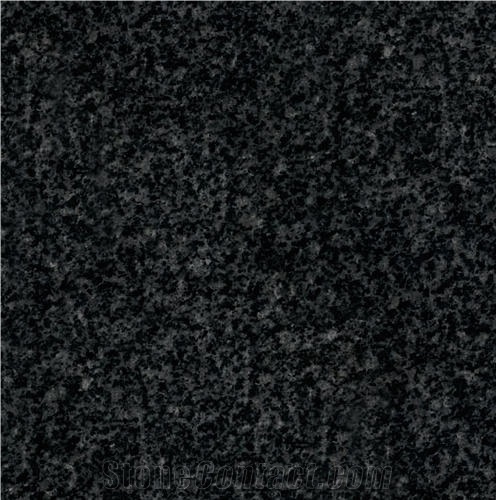Irish Black Granite
 India
India
Irish Black Granite is a kind of black granite quarried in India. This stone is especially good for Bathroom tops, Wall cladding, Counter top, Shower, Dimensional stone, Flooring residential and other design projects. It also called Indian Impala Black Granite . Irish Black Granite can be processed into Polished, Sawn Cut, Sanded, Rockfaced, Sandblasted, Tumbled and so on.

Can India's Irish Black Granite be used exterior applications in very windy climates?

What is the coefficient of friction of Chiseled India's Irish Black Granite tiles?

What is the most popular edge for Irish Black Granite countertops?

Can India's Irish Black Granite be used in a living room?

What edge makes Irish Black Granite countertop look thicker?

Does Irish Black Granite show scratches?

Do Irish Black Granite headstones fade?

Can India's Irish Black Granite be used in wall coverings?

What grade is India's Irish Black Granite?

What is a laminated edge on Irish Black Granite countertop?

Is Irish Black Granite good for commercial flooring?

How thick is India's Irish Black Granite slabs?

Can dish soap damage black granite?

Which is the best granite in India?

Is India's Irish Black Granite an expensive stone?

How often do I need to seal black granite?

Can I change the edge of a Irish Black Granite countertop?

Is Irish Black Granite good for bar countertops?

What is a pencil edge on a Irish Black Granite countertop?

Is it hard to keep Irish Black Granite stair clean?

How often do I need to seal Irish Black Granite floor?

How can I polish Irish Black Granite balustrades?

Is Irish Black Granite gravestone hard to maintain?

How do I finish Irish Black Granite countertop edges?

Where does the cheapest black granite come from?

Where does the best black granite come from?

Can India's Irish Black Granite be used outdoors?

What cleaning materials should not be used on black granite?

Can Irish Black Granite be used for deck stair steps?

Are there color variations of India's Irish Black Granite?
-

 India
India
 10YRDiamond members are premium members on platform, providing members with comprehensive approach to promoting their products, increasing products exposure and investment return to maximize.
10YRDiamond members are premium members on platform, providing members with comprehensive approach to promoting their products, increasing products exposure and investment return to maximize.
 Verified Supplier is for prove company authenticity,including business license,trade license and effective office space,to enhance buyers' trust to suppliers and their products, reducing communication costs.
Verified Supplier is for prove company authenticity,including business license,trade license and effective office space,to enhance buyers' trust to suppliers and their products, reducing communication costs.
Contact Supplier
-

 India
India
 15YRDiamond members are premium members on platform, providing members with comprehensive approach to promoting their products, increasing products exposure and investment return to maximize.
15YRDiamond members are premium members on platform, providing members with comprehensive approach to promoting their products, increasing products exposure and investment return to maximize.
 Verified Supplier is for prove company authenticity,including business license,trade license and effective office space,to enhance buyers' trust to suppliers and their products, reducing communication costs.
Verified Supplier is for prove company authenticity,including business license,trade license and effective office space,to enhance buyers' trust to suppliers and their products, reducing communication costs.
Contact Supplier
-

 India
India
 15YRDiamond members are premium members on platform, providing members with comprehensive approach to promoting their products, increasing products exposure and investment return to maximize.
15YRDiamond members are premium members on platform, providing members with comprehensive approach to promoting their products, increasing products exposure and investment return to maximize.
 Verified Supplier is for prove company authenticity,including business license,trade license and effective office space,to enhance buyers' trust to suppliers and their products, reducing communication costs.
Verified Supplier is for prove company authenticity,including business license,trade license and effective office space,to enhance buyers' trust to suppliers and their products, reducing communication costs.
Contact Supplier
-

 United States
United States
Contact Supplier
-

 China
China
Contact Supplier
-

 China
China
 8YRDiamond members are premium members on platform, providing members with comprehensive approach to promoting their products, increasing products exposure and investment return to maximize.
8YRDiamond members are premium members on platform, providing members with comprehensive approach to promoting their products, increasing products exposure and investment return to maximize.
 Verified Supplier is for prove company authenticity,including business license,trade license and effective office space,to enhance buyers' trust to suppliers and their products, reducing communication costs.
Verified Supplier is for prove company authenticity,including business license,trade license and effective office space,to enhance buyers' trust to suppliers and their products, reducing communication costs.
Contact Supplier
-

-

-

-

The request includes: 1. surface finished, size 2. quantity required






